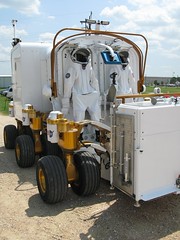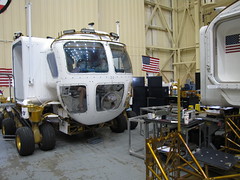Took two glances at the sky as we bobbed behind the dive boat before splashing down. Last view of clouds and blue sky for two weeks.Then the team swam down and along the dive boat, until the Aquarius habitat loomed below us.
One’s first entry into the habitat is met with echoes and deep booming as you stand up out of the water in the metal entry lock. You’re standing in our entrance to the ocean, in a still pool that rises and falls with the surge at the ocean floor, rhythmically sucking the habitat air and burping it outside, or squeezing the air like a piston until your ears pop. The entry lock is a metal box adjoined to the living quarters – you climb a metal staircase to meet our hab techs Nate and James, who have spent most of the day preparing for our arrival.
We rinsed and dried off in a tiny shower at the top of the staircase, found our personal belongings in the small bunkroom, and after a quick lunch of nuts, canned meat, and tortillas, prepared for our first EVAs.
One is constantly distracted and amazed by the new sights and sounds. The view out the windows show a limitless blue, with passing fish always in your periphery. My head was on a swivel for the first few hours, unused to the movement and light in the windows.
You also hear clicking and snapping, like the popping of bubble-wrap, all around you. That’s shrimp and parrot fish feeding off the outside of the habitat.
After two “EVAs”, we are now well-fed and getting ready for the next day’s activities. More on the EVAs tomorrow.

 Dry runs are a critical aspect of any Desert RATS analog field test. After the objectives of this years field test were established, each team went to work on their aspect of the project. Engineers created solutions such as PUP, the Portable Utility Pallet. This device has stowage space, geological evaluation tools, and even a wireless mesh network repeater. As the field test approaches, each subsytem needs to be fully tested and evaluated. Sometimes this is as simple as a functionality test, however it can expand into finding ways to improve durability, usability, and even things such as ergonomics.
Dry runs are a critical aspect of any Desert RATS analog field test. After the objectives of this years field test were established, each team went to work on their aspect of the project. Engineers created solutions such as PUP, the Portable Utility Pallet. This device has stowage space, geological evaluation tools, and even a wireless mesh network repeater. As the field test approaches, each subsytem needs to be fully tested and evaluated. Sometimes this is as simple as a functionality test, however it can expand into finding ways to improve durability, usability, and even things such as ergonomics.  The Desert RATS is a NASA-led team of research partners working together to prepare for human-robotic exploration. This “working group,” led by NASA personnel, is comprised of both NASA and non-NASA Members.
The Desert RATS is a NASA-led team of research partners working together to prepare for human-robotic exploration. This “working group,” led by NASA personnel, is comprised of both NASA and non-NASA Members.